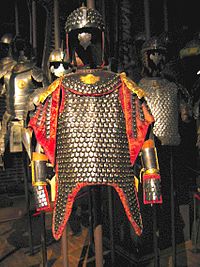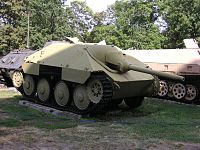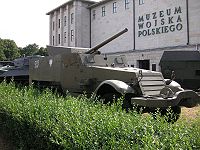Muzeum Wojska Polskiego

The Museum of the Polish Army (Polish Muzeum Wojska Polskiego ) was founded on April 22nd, 1920 by decree of Marshal Józef Piłsudski . It traces the military history of Poland and is largely housed in a side wing of the Polish National Museum in Warsaw . The museum has several branch offices in Warsaw and, with a collection of over 250,000 exhibits, is the largest military museum in Poland and the second largest in Warsaw.
history
Between the two world wars
As early as January 1919, a group of young Polish officers led by Lieutenant Karol Zyndram Maszkowski initiated the establishment of the Muzeum Wojsk ("Army Museum") in the Warsaw Royal Castle . Mainly exhibits from the First World War were kept here. This museum existed for around 18 months. On April 22nd, 1920, a museum of the same name ( Muzeum Wojsk ) was founded by decree for administrative reasons . It took over the collection in the city palace. The new museum was located together with the National Museum in Warsaw's old town in a former Basilian monastery building at 15 Podwale Street. The organizer and first director of the museum was Bronisław Gembarzewski , a pioneer colonel in the Polish army and later a military historian. The collection was first made available to the public in 1922. In 1923 the collection was expanded with the return of Polish exhibits from the USSR . In 1929 exhibits from the Polish Museum in Rapperswil were transferred from Switzerland. Other exhibits came from the holdings of the Polish Army and from private collections (such as that of Wincenty Krasiński ).
In 1933 the company moved to a newly constructed museum building at Aleje Jerozolimskie 3 in downtown Warsaw. On August 8, 1934, the museum was reopened to the public. The driving force behind the move and the redesign was Kazimierz Sosnkowski, chairman of the museum's board of trustees for many years .
From 1939 to 1989
When the Second World War broke out , the museum had around 30,000 exhibits. During the occupation of Poland by German troops, some of the stocks were brought to Germany. In 1944 the name was changed to Muzeum Wojska Polskiego ("Museum of the Polish Army"). After returning the exhibits that had been shipped to Germany, the museum was able to resume operations in 1946.
The museum's holdings grew mainly through the handover of weapons and uniforms from those Polish military units that were deployed in Western Europe during the Second World War. Germany had to return the standards captured in 1939 , and the USSR handed over a cannon from the 17th century and other historical exhibits. After 1989, other items were returned from Russia.
After 1989
In 1993 the Katyń Museum and the Museum of Polish Military Technology ( Muzeum Polskiej Techniki Wojskowej ) opened in the former Czerniakowski Fort . Another branch is the collection of the Art Gallery of the Museum of the Polish Army ( Galeria Sztuki Muzeum Wojska Polskiego) at 11 Krakowskie Przedmieście Street.
The museum's collections contain over 100,000 items, 80,000 illustrations, 30,000 documents, 30,000 historical books and 11,000 magazines or newspapers. The museum also has an extensive specialist library and a restoration workshop. The advantages (access to other exhibits) of this connection are offset by disadvantages (such as the restriction of employment). The museum is a member of the International Committee for Museums of Arms and Military History ( ICOMAM ) and the Polish National Committee of the International Council of Museums ( ICOM-Poland ) at the International Council of Museums (ICOM).

Overview of the collections
The objects on display essentially relate to the history of the Polish army from the Middle Ages to modern times. This includes armor, cut, stabbing and firearms, uniforms, standards, medals, riding accessories, naval and air force equipment as well as hunting and sporting weapons. Military equipment from other parts of Europe (15th – 19th centuries) and the world (16th – 19th centuries) is also on display. These collections are supplemented by exhibits from the field of ballistics.
The art collections consist of battle paintings, engravings, posters and drawings. In addition, extensive stocks of maps, books, photographs and other documents are kept, but only partially presented.
The exhibition theme
The first exhibition rooms deal with the development of Poland from the beginnings of the military and state to the height of military strength in the 17th century. This was followed by anarchy-like conditions in the 18th century, which culminated in the three Polish divisions . Other halls are dedicated to the participation of Polish troops in the Napoleonic Wars and the two national uprisings in 1830 and 1861 . The focus of the exhibitions, however, is in the 20th century and especially in the Second World War.
Significant exhibits
Important exhibits in the museum are the swords and sabers of Kings Stefan Batory and Stanisław August Poniatowski , Prince Józef Poniatowski , Marshal Edward Rydz-Śmigły , the hetman Jan Zamoyski and the generals Jan Henryk Dąbrowski , Józef Piłsudski and Marian Langiewicz .
Armor and helmets of important Polish and Lithuanian rulers and generals are also exhibited : such a Zischägge from the 10th-11th centuries. Century by Mieszko I. or Bolesław Chrobry , the tournament armor "Żabi pysk" (from Nuremberg , around 1530), the equestrian uniform of the Lithuanian hetman Krzysztof Radziwiłł Piorun and the parade helmet of the hetman Jan Amor Tarnowski from the 16th century as well as the hussar uniform of Stanisław Skórkowski , a parade chain armor from King Jan Kazimierz and a scale armor from the 17th century.
Also noteworthy are a Turkish-style mace from the second half of the 17th century by the hetman Stanisław Jan Jabłonowski and the saddles by Stefan Czarniecki , Stanisław Leszczyński (a coronation saddle), Napoleon Bonaparte (used during the Egyptian campaign in 1799) and General Jan Henryk Dąbrowski .
The uniforms of important Polish officers such as Józef Haller , Jan Kozietulski , Zygmunt Berling , Jan Henryk Dąbrowski , Stanisław Sosabowski , Władysław Sikorski , Kazimierz Sosnkowski , Stanisław Rostworowski , Wacław Sieroszewski and Judzef Pi are on display.
Finally, the general cap of Tadeusz Kościuszko , the flag of the scythe fighters ( Kosynierzy ) of the anti-Russian Kościuszko uprising from 1794, a sword and a Gothic relic of the Lord Master of the Teutonic Order , which were taken by the victorious Polish knights during the Battle of Tannenberg. Lithuanian troops captured.
The firearms on display include a pistol by Józef Antoni Poniatowski , a “ Mors ” submachine gun (of which there are only three examples worldwide), a Błyskawica MP from 1943, a heavy machine gun wz. 30 and a Pistolet Vis wz. 35 from a prototype series.
Finally, the museum owns the works of important artists such as Józef Brandt , Józef Chełmoński and Wojciech Kossak as well as sculptures by Xawery Dunikowski , Michał Kamieński and Edward Wittig .
Permanent exhibitions
- Armed Polish units of the Middle Ages
- The Polish Army during the Renaissance
- The history of the Polish military from 1576 to 1648
- The Polish Army in the second half of the 17th century
- The Polish Army in Saxon times
- Time of the Enlightenment and the Kościuszko Uprising
- Polish legions in Italy and the army of the Duchy of Warsaw
- The Army of the Kingdom of Poland and the November Uprising of 1830–31
- The January uprising of 1863
- Polish paramilitary organizations in the early 20th century
- Paths to Independence (1914–1945)
- The Polish Army 1921–1939
- Poland's War of Defense 1939
- The Armed Resistance in the Occupied Country (1939–1947)
- The Polish Army in the East (1943–1945)
- The UN peacekeeping missions of the Polish army
Photos of selected exhibits in the interior
Parade chain armor of King Jan Kazimierz from the 17th century.
Bogdan Willewalde : The Battle of Grochów (1831)
Aleksander Sochaczewski : Polish soldiers in the Russian army (1863)
January Suchodolski : The Battle of Fuengirola
Jan Rosen : The Battle of Stoczek (1831)
Outdoor area
On the area in front of the museum entrance there is heavy military equipment, which mainly comes from the Second World War. Most of the armored vehicles, planes, trucks and cannons belonging to the museum are exhibited in the branch in the Czerniakowski Fort in the Muzeum Polskiej Techniki Wojskowej . Only selected individual pieces are shown outside of the Museum of the Polish Army.
The aircraft here are a TS-8 Bies , a TS-11 Iskra , a PZL-130 Orlik , a PZL I-22 Iryda , an An-26 , a MiG-23 , Su-20 and an IL-2 . Armored vehicles are among other by TKS - Tankette , a T-34 with 76-mm cannon from 1942 and the Warsaw Uprising tanks used Kubuś represented. There are also five cannon barrels, which were made around the turn of the 16th and 17th centuries. Century Nieswiez for Mikołaj Radziwiłł cast and in the vicinity of the castle in Zabierz were found and a Bofors-WZ-36 - tank gun .
Photos of selected exhibits in the outdoor area
French cutter mortar ( model 280 ) from 1914
MiG-29 of the Polish Armed Forces
Polish TKS tankette with a 7.9 mm Hotchkiss machine gun
Heavy main battle tank IS-2 with a 122 mm cannon
German tank destroyer ("Hetzer")
An M3 half-track with a 57mm cannon
Planned new building
On December 15, 2008, the museum announced an international architecture tender for a new building in the Warsaw Citadel in Warsaw's Żoliborz district . In line with the successful concept of the Museum of the Warsaw Uprising , the new museum will be equipped with multimedia equipment and be completed in 2015. It is expected to cost 480 million zlotys. The new museum should be able to exhibit 20,000 exhibits (so far only around 2,000 pieces of the inventory can be shown). The current museum premises in Aleje Jerozolimskie are to be taken over by the National Museum.
See also
literature
- Dotknij Niepodległości w Muzeum Wojska Polskiego, 11th Listopada 2010 godz. 13-20. in the daily newspaper Rzeczpospolita of November 9, 2010, page 16
- Poland. Baedeker Allianz travel guide. Verlag Karl Baedeker, Ostfildern 1993, p. 406, ISBN 3-87504-542-4
Web links
- Museum website
- Project views of the planned new building of the museum in the Warsaw Citadel at Architektura.info and Gazeta.pl
References and comments
- ^ The Museum of the Polish Army ( Memento of May 29, 2006 in the Internet Archive ) on the Warsaw City Council website
- ^ Wielka Encyclopedia PWN. Volume 18, p. 236, Warsaw 2003, ISBN 8301133570 .
- ↑ Jerzy Majewski: W tym Pałacu przechowywali miecze for Grunwaldu. www, warszawa.wyborcza.pl, July 16, 2010, accessed November 23, 2016 (Polish).
- ↑ www.culture.pl: The Polish Military Museum. (No longer available online.) Archived from the original on February 3, 2011 ; accessed on November 23, 2016 . Info: The archive link was inserted automatically and has not yet been checked. Please check the original and archive link according to the instructions and then remove this notice.
- ↑ Readable on a bilingual information board at the entrance to the museum (November 2010)
- ↑ www.culture.pl: The Polish Military Museum. Accessed November 23, 2016 .
- ↑ Stanisław Skórkowski was the secretary of King Władysław IV.
- ↑ The submachine gun "Mors" (Latin for: death, Polish for: walrus ) was a submachine gun developed by Piotr Wilniewczyc and Jan Skrzypiński in the years 1936 to 1938 and was based on the German ERMA EMP-35 , but had a downside Magazine pointing (instead of to the left). She was to become the standard MP in the Polish Army. When the German invasion, however, production was interrupted. By September 1939, the carbine factory ( Fabryka Karabinów ) in Warsaw was only able to produce three prototypes and only 36 copies.
- ↑ The carabiner ckm wz. 30 ( ciężki karabin maszynowy ) was a heavy machine gun and the Polish version of the American Browning M1917 . It was an unlicensed, almost identical copy of the American weapon and was the standard machine gun of the Polish army of its time.
- ↑ During the battle of Fuengirola on October 15, 1810, an outnumbered Polish garrison held the medieval fortress in Fuengirola against a Spanish-British expeditionary force under Lord Andrew Thomas Blayney.
- ↑ The Battle of Stoczek was the first significant battle of the November uprising in 1830. It took place on February 14, 1831 near the village of Stoczek Łukowski on the road from Brest to Warsaw.
- ↑ Kubuś (Polish: "Little Jacob") was the name of an armored personnel carrier for eight to twelve soldiers. August 1944 in Warsaw underground based on a truck Chevrolet 157 was built. The vehicle was armed with a Soviet DP-MG and a self-made flamethrower. It was used from August 22 to September 6, 1944 during the fighting of the Warsaw Uprising.
- ↑ according to Article by Paul-Richard Gromnitza in: The city of Warsaw is investing billions in a new museum landscape ( Memento from November 14, 2010 in the Internet Archive ) at de-pl.info
- ↑ according to Article 400 milionów złotych pochłonie nowe Muzeum Wojska Polskiego ( Memento of September 3, 2009 in the Internet Archive ) at Tvnwarszawa.pl (in Polish)
Coordinates: 52 ° 13 ′ 55 ″ N , 21 ° 1 ′ 33 ″ E















